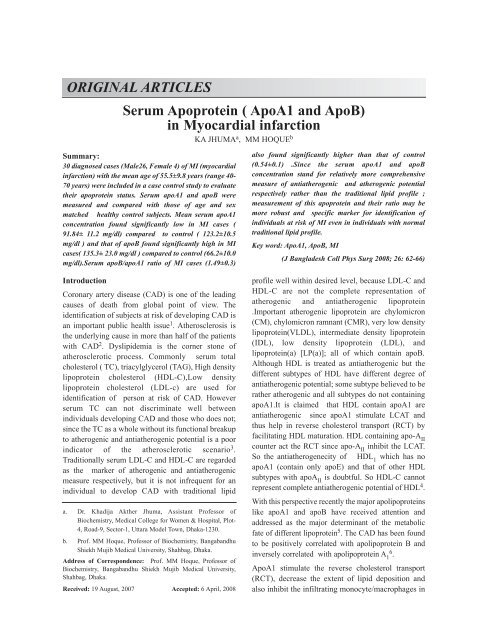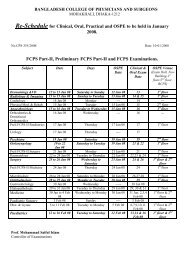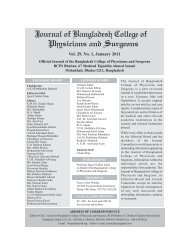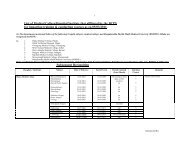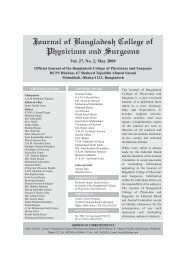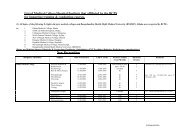May 2008 - bcps
May 2008 - bcps
May 2008 - bcps
You also want an ePaper? Increase the reach of your titles
YUMPU automatically turns print PDFs into web optimized ePapers that Google loves.
ORIGINAL ARTICLESSerum Apoprotein ( ApoA1 and ApoB)in Myocardial infarctionKA JHUMA a , MM HOQUE bSummary:30 diagnosed cases (Male26, Female 4) of MI (myocardialinfarction) with the mean age of 55.5±9.8 years (range 40-70 years) were included in a case control study to evaluatetheir apoprotein status. Serum apoA1 and apoB weremeasured and compared with those of age and sexmatched healthy control subjects. Mean serum apoA1concentration found significantly low in MI cases (91.84± 11.2 mg/dl) compared to control ( 123.2±10.5mg/dl ) and that of apoB found significantly high in MIcases( 135.3± 23.0 mg/dl ) compared to control (66.2±10.0mg/dl).Serum apoB/apoA1 ratio of MI cases (1.49±0.3)also found significantly higher than that of control(0.54±0.1) .Since the serum apoA1 and apoBconcentration stand for relatively more comprehensivemeasure of antiatherogenic and atherogenic potentialrespectively rather than the traditional lipid profile ;measurement of this apoprotein and their ratio may bemore robust and specific marker for identification ofindividuals at risk of MI even in individuals with normaltraditional lipid profile.Key word: ApoA1, ApoB, MI(J Bangladesh Coll Phys Surg <strong>2008</strong>; 26: 62-66)IntroductionCoronary artery disease (CAD) is one of the leadingcauses of death from global point of view. Theidentification of subjects at risk of developing CAD isan important public health issue 1 . Atherosclerosis isthe underlying cause in more than half of the patientswith CAD 2 . Dyslipidemia is the corner stone ofatherosclerotic process. Commonly serum totalcholesterol ( TC), triacylglycerol (TAG), High densitylipoprotein cholesterol (HDL-C),Low densitylipoprotein cholesterol (LDL-c) are used foridentification of person at risk of CAD. Howeverserum TC can not discriminate well betweenindividuals developing CAD and those who does not;since the TC as a whole without its functional breakupto atherogenic and antiatherogenic potential is a poorindicator of the atherosclerotic scenario 3 .Traditionally serum LDL-C and HDL-C are regardedas the marker of atherogenic and antiatherogenicmeasure respectively, but it is not infrequent for anindividual to develop CAD with traditional lipida. Dr. Khadija Akther Jhuma, Assistant Professor ofBiochemistry, Medical College for Women & Hospital, Plot-4, Road-9, Sector-1, Uttara Model Town, Dhaka-1230.b. Prof. MM Hoque, Professor of Biochemistry, BangabandhuShiekh Mujib Medical University, Shahbag, Dhaka.Address of Correspondence: Prof. MM Hoque, Professor ofBiochemistry, Bangabandhu Shiekh Mujib Medical University,Shahbag, Dhaka.Received: 19 August, 2007 Accepted: 6 April, <strong>2008</strong>profile well within desired level, because LDL-C andHDL-C are not the complete representation ofatherogenic and antiatherogenic lipoprotein.Important atherogenic lipoprotein are chylomicron(CM), chylomicron ramnant (CMR), very low densitylipoprotein(VLDL), intermediate density lipoprotein(IDL), low density lipoprotein (LDL), andlipoprotein(a) [LP(a)]; all of which contain apoB.Although HDL is treated as antiatherogenic but thedifferent subtypes of HDL have different degree ofantiatherogenic potential; some subtype believed to berather atherogenic and all subtypes do not containingapoA1.It is claimed that HDL contain apoA1 areantiatherogenic since apoA1 stimulate LCAT andthus help in reverse cholesterol transport (RCT) byfacilitating HDL maturation. HDL containing apo-A IIcounter act the RCT since apo-A IIinhibit the LCAT.So the antiatherogenecity of HDL 1which has noapoA1 (contain only apoE) and that of other HDLsubtypes with apoA IIis doubtful. So HDL-C cannotrepresent complete antiatherogenic potential of HDL 4 .With this perspective recently the major apolipoproteinslike apoA1 and apoB have received attention andaddressed as the major determinant of the metabolicfate of different lipoprotein 5 . The CAD has been foundto be positively correlated with apolipoprotein B andinversely correlated with apolipoprotein A 1 6 .ApoA1 stimulate the reverse cholesterol transport(RCT), decrease the extent of lipid deposition andalso inhibit the infiltrating monocyte/macrophages in


